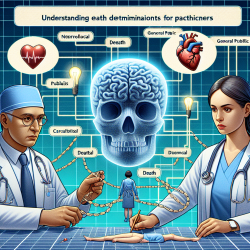Understanding Death Determination: Insights for Practitioners
The question of "When is a person dead?" is not only a philosophical inquiry but also a critical medical question that impacts clinical practice, organ donation, and public perception. A recent nationwide survey in Canada, published in the Canadian Journal of Anesthesia, sheds light on the public's understanding and perception of death determination by neurologic and circulatory criteria. This blog aims to distill the findings of the survey and explore how practitioners can use this data to improve their practice and public engagement.
Survey Overview and Key Findings
The survey involved 2,000 Canadian respondents and aimed to evaluate their understanding of death determination through two scenarios: one based on neurologic criteria (brain death) and the other on circulatory criteria. The results revealed that 67.2% of respondents believed the individual in the neurologic scenario was dead, compared to 81.2% in the circulatory scenario. This indicates a higher level of public acceptance and understanding of circulatory death determination.
Interestingly, those who disagreed or were unsure about the death status in both scenarios cited a need for more information, such as brain imaging results or a third doctor's opinion. Younger age, religious beliefs, and residing in Quebec were predictors of disbelief in death determination by both criteria.
Implications for Practitioners
For practitioners, these findings highlight the importance of clear communication and education regarding death determination. Here are some actionable insights:
- Enhance Communication: Provide clear explanations of death determination criteria to patients and their families. Use visual aids like brain imaging results to support your explanations.
- Address Religious and Cultural Concerns: Be sensitive to the religious and cultural beliefs of patients and their families. Engage with spiritual leaders when necessary to facilitate understanding and acceptance.
- Leverage Trusted Sources: The survey found that most respondents prefer to receive information from healthcare professionals. Utilize this trust to educate the public through written materials and direct conversations.
Opportunities for Further Research
The survey indicates a high level of interest among Canadians in learning more about death determination. This presents an opportunity for practitioners to engage in public education initiatives. Consider collaborating with organizations like the Canadian Blood Services to develop educational programs that address common misconceptions and provide accurate information.
Conclusion
Understanding public perceptions of death determination is crucial for healthcare practitioners. By leveraging the insights from this survey, practitioners can improve communication, address cultural and religious concerns, and engage in meaningful public education. These efforts can enhance public trust and acceptance of death determination practices.
To read the original research paper, please follow this link: When is a person dead? The Canadian public’s understanding of death and death determination: a nationwide survey.










